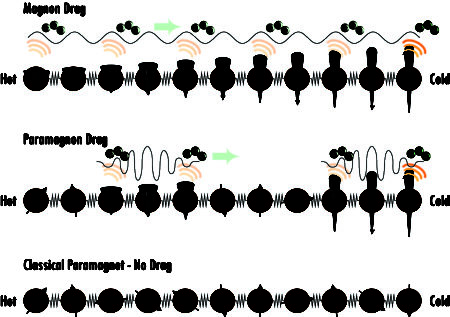Sep
17
New Research Finds a Way to Make Electricity From Heat
September 17, 2019 | Leave a Comment
This effect, which the researchers call ‘paramagnon drag thermopower,’ is a local thermal perturbations of spins in a solid that can convert heat to energy even in a paramagnetic material – where spins weren’t thought to correlate long enough to do so.
The discovery could lead to more efficient thermal energy harvesting. For example, by converting car exhaust heat into electric power to enhance fuel-efficiency, or powering smart clothing by body heat.

Magnon and paramagnon drag: Magnons, waves created by spins of individual atoms (grey cones) drag electrons (green dots) along a thermal gradient to create thermopower. In the paramagnetic state, local thermal fluctuations form small magnon packets that can similarly drag electrons. Classical paramagnets do not produce drag. Image Credit: Renee Ripley, Ohio State University. Click image for the largest view.
The research team includes scientists from North Carolina State University, the Department of Energy’s Oak Ridge National Laboratory (ORNL), the Chinese Academy of Sciences and Ohio State University. The working group’s research paper has been published in the journal Science Advances.
Now for some explanation.
In solids with magnetic ions (e.g., manganese), thermal perturbations of spins either can align with each other (ferromagnets or antiferromagnets), or not align (paramagnets). However, spins are not entirely random in paramagnets: they form short-lived, short-range, locally ordered structures – paramagnons – which exist for only a millionth of a billionth of a second and extend over only two to four atoms. In the new paper describing the work, the researchers show that despite these shortcomings, even paramagnons can move in a temperature difference and propel free electrons along with them, creating paramagnon drag thermopower.
In a proof-of-concept finding, the team observed that paramagnon drag in manganese telluride (MnTe) extends to very high temperatures and generates a thermopower that is much stronger than what electron charges alone can make.
The research team tested the concept of paramagnon drag thermopower by heating lithium-doped MnTe to approximately 250 degrees Celsius above its Néel temperature (34 degrees Celsius) – the temperature at which the spins in the material lose their long-range magnetic order and the material becomes paramagnetic.
Daryoosh Vashaee, professor of electrical and computer engineering and materials science at NC State and co-corresponding author of the paper describing the work said, “Above the Néel temperature, one would expect the thermopower being generated by the spin waves to drop off. However, we didn’t see the expected drop off, and we wanted to find out why.”
At ORNL the team used neutron spectroscopy at the Spallation Neutron Source to determine what was happening within the material.
Raphael Hermann, a materials scientist at ORNL and co-corresponding author of the paper said, “We observed that even though there were no sustained spin waves, localized clusters of ions would correlate their spins long enough to produce visible magnetic fluctuations.”
The team showed that the lifetime of these spin waves – around 30 femtoseconds – was long enough to enable the dragging of electron charges, which requires only about one femtosecond, or one quadrillionth of a second.
“The short-lived spin waves, therefore, could propel the charges and create enough thermopower to prevent the predicted drop off,” Hermann noted.
Joseph Heremans, professor of mechanical and aerospace engineering at the Ohio State University and co-corresponding author of the paper took the explanation further with, “Before this work, it was believed that magnon drag could exist only in magnetically ordered materials, not in paramagnets. Because the best thermoelectric materials are semiconductors, and because we know of no ferromagnetic semiconductor at room temperature or above, we never thought before that magnon drag could boost the thermoelectric efficiency in practical applications. This new finding changes that completely; we can now investigate paramagnetic semiconductors, of which there are a lot.”
Huaizhou Zhao, a professor at the Chinese Academy of Science in Beijing and co-corresponding author of the paper added, “When we observed the sudden rise of Seebeck coefficient below and near the Néel temperature, and this excess value extended to high temperatures, we suspected something fundamentally related to spins must be involved. So we formed a research team with complementary expertise which laid the groundwork for this discovery.”
Professor Vashaee summed up with, “Spins enable a new paradigm in thermoelectricity by alleviating the fundamental tradeoffs imposed by Pauli exclusion on electrons. Just as in the discovery of the spin-Seebeck effect, which led to the new area of spincaloritronics, where the spin angular momentum is transferred to the electrons, both the spin waves (i.e., magnons) and the local thermal fluctuations of magnetization in the paramagnetic state (i.e., paramagnons) can transfer their linear momentum to electrons and generate thermopower.”
Graduate students and co-first authors Yuanhua Zheng of the Ohio State University, Tianqi Lu of the Chinese Academy of Sciences and Mobarak H. Polash of NC State contributed equally to the work. The Spallation Neutron Source at ORNL is a DOE Office of Science User Facility. The research has been supported by the National Science Foundation, the Air Force Office of Scientific Research, and the U.S. Department of Energy Office of Science, Basic Energy Sciences, Materials Sciences and Engineering Division.
Humanity lets more than half of the energy and fuel used escape as heat. Harvesting that waste and using would effectively double the amount of work that could be done or cut the costs of energy and fuels.
This technology is so new that there isn’t any efficiency noted or even volt values let alone amps. But as one researcher noted, there is now the whole range of semiconductors in play for research. Something worthwhile will come of this for energy and fuel users. Your humble writers believes heat harvesting is the “holy grail” of energy and fuels in the short term or first step, making this is very good news, indeed.

